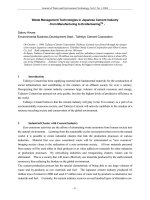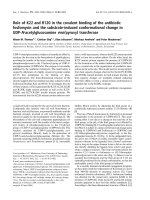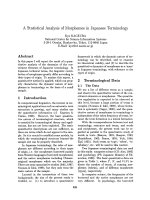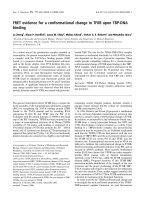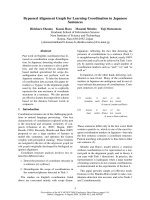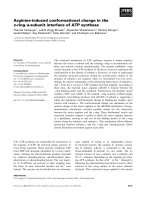3D manufacturing innovation revolutionary change in japanese manufacturing with digital data
Bạn đang xem bản rút gọn của tài liệu. Xem và tải ngay bản đầy đủ của tài liệu tại đây (8.27 MB, 168 trang )
3D Manufacturing Innovation
Tai ngay!!! Ban co the xoa dong chu nay!!!
Hiroshi Toriya
3D Manufacturing
Innovation
Revolutionary Change in Japanese
Manufacturing with Digital Data
Translated by Yukie Ito
123
Hiroshi Toriya, PhD
President and CEO
Lattice Technology, Co., Ltd.
4F Hiei-Kudan Building,
3-8-11 Kudan-Minami, Chiyoda-ku
Tokyo 102-0074
Japan
ISBN 978-1-84800-037-7
e-ISBN 978-1-84800-038-4
DOI 10.1007/978-1-84800-038-4
British Library Cataloguing in Publication Data
Toriya, H. (Hiroshi), 19603D manufacturing innovation : revolutionary change in
Japanese manufacturing with digital data
1. CAD/CAM systems - Japan
I. Title
670.2'85
ISBN-13: 9781848000377
Library of Congress Control Number: 2007942724
© 2008 Springer-Verlag London Limited
Previously published in Japanese by Nikkei Business Publications, as 3
(3D
Manufacturing Innovation):
(Revolutionary Change in Japanese
Manufacturing with Digital Data, by Hiroshi Toriya, 2006, ISBN 978-4-8222-1892-8.
Apart from any fair dealing for the purposes of research or private study, or criticism or review, as permitted
under the Copyright, Designs and Patents Act 1988, this publication may only be reproduced, stored or
transmitted, in any form or by any means, with the prior permission in writing of the publishers, or in the case
of reprographic reproduction in accordance with the terms of licences issued by the Copyright Licensing
Agency. Enquiries concerning reproduction outside those terms should be sent to the publishers.
The use of registered names, trademarks, etc. in this publication does not imply, even in the absence of a
specific statement, that such names are exempt from the relevant laws and regulations and therefore free for
general use.
The publisher makes no representation, express or implied, with regard to the accuracy of the information
contained in this book and cannot accept any legal responsibility or liability for any errors or omissions that
may be made.
Cover design: eStudio Calamar S.L., Girona, Spain
Printed on acid-free paper
9 8 7 6 5 4 3 2 1
springer.com
Foreword
Mr. Kentaro Kizaki
Nikkei Monozukuri Editor, Nikkei Business Publications, Inc.
Amidst the intensifying competition revolving beyond national borders in the
manufacturing industry, what is the competitive edge required for manufacturers
to survive? Competitive edge can be visible and invisible. “Visible competitive
edge” means it is visible to customers, such as new mechanisms of products, materials, machining technologies, etc. It can also be called product innovation. In
contrast, “invisible competitive edge” is competitive edge in the business process,
in other words, competitive edge created by innovation of design and production
processes, or by the establishment of mechanisms for manufacturing quality products quickly and inexpensively by the introduction of IT or human resource development.
Indispensable to this “invisible competitive edge” is no doubt the use of 3D for
the design and manufacturing processes. With the growing use of 3D CAD in design departments, 3D data-based manufacturing is becoming more and more common. In design departments, 3D data is used as the material for verifying design,
and in manufacturing departments, 3D data is used for machining and automatic
assembly. 3D data is also used for enhancing the manufacturing process to facilitate the work of assembly operators. Procurement and marketing departments can
also use 3D data for their procurement, sales, and logistics activities as predictors.
In whichever case, 3D data is a tool which supports in ways invisible to customers
of the manufacturing industry. The full and thorough use of 3D data will reinforce
invisible competitive edge. According to Professor Takahiro Fujimoto of the University of Tokyo (Graduate School of Economics), “MONOZUKURI” (manufacturing or making in Japanese) is the transcription of design information onto media.
He says, for example, an automobile is the transcription of design concepts of
a vehicle onto a 0.8-mm-thick metal sheet. Important here is the fact that satisfying
the customer is not the medium of metal sheet but the design information itself.
And the means of conveying this design information from designers to production
engineers are drawings or 3D data, etc.
v
vi
Foreword
Japanese Drawings: Designed to Facilitate Production
Technology Plans
At the moment (2007), most 3D CAD software products used in design departments are from Europe or the USA. The use of 3D CAD enables designers to
define 3D models precisely as well as convey shapes accurately to those applying
production technologies. 3D CAD is very clear-cut, nothing is vague, so it tries to
provide all the information required in the downstream process. This was why
CAD was developed in Europe and the USA. On the other hand, the aim of drawings used in Japan has been for designers to relay design details to production
engineers. The process of preparing these drawings consisted only of reconstructing design information so that production engineers can understand the information better. So the production engineers would look at the drawings, try to understand the intent of designers, and work on the production process. This creativity
at the production side is what strengthens the foundations of the Japanese manufacturing industry.
In manufacturing, 3D CAD data is, needless to say, very useful. There are very
keen efforts to realize “drawing-less” manufacturing by digitizing information
transmission and abolishing drawings. However, it is risky to simply replace
drawings with 3D CAD data. This is because the meanings of drawings and 3D
data are totally different in production engineering.
If the strengths of the manufacturing industry to date are to be made use of, it is
necessary to use 3D CAD data but, at the same time, apply a method which will
reliably convey designer intent such as tolerance and important details to the production process. Such a reliable method would be lightweight 3D data as represented by XVL. Lightweight 3D data should not be taken as the simplified version
of CAD data, because not only production engineering departments but also various departments can access this lightweight 3D data to learn about design intent.
For this, large-scale assembly data must be viewable and easily accessed by virtually anyone.
Japan Leads the World in Use of 3D Data
Japan clearly leads the world in the use of 3D data. Lightweight 3D data XVL was
developed by the Japanese company Lattice Technology (hereafter referred to as
Lattice) and is growing more and more popular. Other lightweight 3D data software include Fujitsu’s VPS and Digital Process’ VridgeR. Though differing in the
functions provided, Japan has pioneered the use of 3D data software. This can
probably be attributed to the sophisticated skills of users of XVL and 3D tools, in
other words, production engineering departments of Japanese companies.
It is natural for Japanese industry to reinforce its manufacturing strengths
through IT. As European and American CAD software have already penetrated
Foreword
vii
deeply into the Japanese market, there is not much value in developing Japanese
CAD systems now. So in order to strengthen the Japanese manufacturing industry,
we need software that matches Japan’s manufacturing culture. One such software
would be software enhancing collaboration between design departments and manufacturing departments such as production engineering. In order for Japan to
carry out concurrent engineering the Japanese way, it will need mechanisms for
production-related staff to participate in the design process from an early stage.
This would be design review using 3D data as a tool for communication between
different departments.
From the perspective of the partnership between design and manufacturing,
design reviews embody the bottom-up approach where optimization proceeds by
trial and error. In contrast, European and American software vendors propose the
concept of realizing overall optimization all at once, called Product Lifecycle
Management (PLM). PLM is a top-down approach where attempts are made to
manage and use information in the product lifecycle from upstream to downstream to enhance the competitive edge. In reality, this approach for overnight
reforms is sometimes difficult. When attempts are made to resolve a big problem,
it is usually difficult to decide where to start from. It is therefore more realistic to
start by accumulating CAD data and lightweight 3D data in the company’s common database so that people requiring information can access it. Once more and
more people are using the data, then it is time to enhance software and hardware.
The fact that lightweight 3D data such as XVL allows such a bottom-up approach
makes it advantageous in reinforcing Japan’s strengths.
Preface
It is said that good users are essential to the birth of good software, because it is
the discerning users who help foster software quality. This book discusses the uses
of 3D data mainly in the Japanese manufacturing industry. Originally, 3D CAD,
CAM, and CAE data was used exclusively for product design. However, in recent
years, the Japanese manufacturing industry has used 3D data to revolutionize
manufacturing processes. By using lightweight 3D formats such as XVL, Lattice
Technology’s eXtensible Virtual world description Language, Japanese manufacturers have improved production and laid the groundwork for innovative new
methods of corporate communication.
This book discusses how leading Japanese manufacturers use 3D data in downstream processes, how the IT infrastructure required for this has been built, and
some of the trial and error behind these developments. Each of the companies
introduced as case studies are leaders in Japanese industry. It should be particularly interesting to European and American manufacturers to learn how their counterparts in Japan make use of IT to gain competitive strength. In fact, European
and American manufacturers are starting to use 3D in downstream processes; this
book includes examples from three leading manufacturers. It is interesting to note
that the software described in this book, which supports manufacturing, a forte of
Japan, was also developed in Japan, demonstrating that outstanding software is
indeed nurtured by outstanding users.
We sometimes hear people talk about the CRIC cycle, which stands for crisis,
response, improvement, and complacency. When faced with a crisis, people respond and try to fix the problem. The conditions improve, and then complacency
sets in. But what happens if the solution is a “quick fix” that does not solve the
underlying problem? People are complacent, but the risk remains – a trap we are
all apt to fall into.
The CRIC cycle can sometimes be seen in the manufacturing industry. Manufacturers constantly strive to enhance quality, cut costs, and shorten delivery
times. 3D CAD/CAM/CAE has been embraced as a solution to these challenges.
In the 1990s, Boeing started using 3D CAD to design its 777 family of aircraft.
This endeavor, which involved intense collaboration with partner companies,
demonstrated clearly the advantages of concurrent engineering using 3D design.
ix
x
Preface
At the same time, China was seen to rapidly adopt 3D design, skipping the
2D CAD drawing step that other nations had gone through. Japanese industry
experienced a sense of crisis and rushed to start using 3D CAD as well. This was
how applications of 3D design in Japan started to shift into full swing. It is now
expected that Japanese manufacturers will be able to innovate their production
processes using the 3D CAD data that has accumulated in design departments.
However, in reality, many companies do not seem to be fully utilizing the
3D CAD software which they have procured. In addition, many companies that
have embraced 3D design are using 3D data only for checking simple 3D shapes
and drawing illustrations very limited applications. It looks like these companies
have fallen into the trap of the CRIC cycle. It is said that if the path from crisis to
complacency is long, the path that follows is also long. This means that if the
cycle prolongs, it becomes difficult to break away from the crisis. These companies therefore need to ask if they are content to just have installed CAD, or to just
be using the 3D data for limited purposes, and if the improvement measures they
have implemented are not simply quick fix solutions.
Adoption of 3D CAD incurs huge costs for procuring and installing expensive
hardware and software, training costs for designers and engineers, and costs for
changing business processes. However, often the 3D CAD data generated at such
high costs is used only in design and manufacturing, which make up less than
10% of the whole IT domain. The other 90% sees no benefit from this data.
Often this is blamed on the large size and complexity of 3D data which makes it
difficult to use. However, things are changing with the emergence of lightweight
3D data formats and viewers in recent years, which is increasing the use of 3D
data not only inside the company but also outside. This is a natural development
because 3D data can be understood intuitively and is an optimum tool for communication. Even Microsoft Windows Vista is equipped with a 3D viewer function, which is expected to increase the visibility and importance of 3D data.
This book introduces methods of using 3D data to enhance competitive strength
in manufacturing. Chapter 1 explains the current situation of 3D design in Japan,
a source of competitive strength of the Japanese manufacturing industry. Chapter 2 describes the background of lightweight 3D data. Chapter 3 introduces the
pioneering case study of SONY which describes how to build an information
infrastructure for 3D data. Chapter 4 discusses the advantages of using general
lightweight 3D data, and Chapters 5–13 are case studies of leading manufacturers
that have innovated business processes using 3D data. The lessons learned from
their efforts are summarized in Chapter 14, and the lightweight 3D tools that these
companies used are explained in the two appendices.
This book hopes to capture the essence of using 3D by examining leading edge
efforts in 3D data applications. Though 3D can be beneficial for limited applications, such an approach fails to capitalize on the benefits of 3D data. Only by
standardizing 3D use across the enterprise can companies fully realize the value of
3D data and break the CRIC cycle.
The use of lightweight 3D data is an attempt to incorporate IT into manufacturing technologies. The goal of the use of 3D data is to eliminate all unnecessary
Preface
xi
work of designers and manufacturing staff so that they can concentrate on innovative work. In addition, by sharing knowledge from design and manufacturing with
downstream departments, quality and productivity can be enhanced throughout the
company. By taking readers through 3D data uses by pioneering companies, this
book hopes to show how IT can be used to improve manufacturing not just in
Japan, but all over the world.
Acknowledgments
In writing this book, I had the opportunity to speak with many users of XVL who
provided valuable information and insight. My deepest thanks goes to Mr. Masashi Watanabe, Mr. Hiroshi Sekiya, Mr. Hideki Yoshii, and Mr. Taichi Tsukamoto
of SONY Global Solutions, Mr. Junichi Harada and Mr. Shigeharu Ueyama
of TOYOTA, Mr. Kiyotaka Yamamoto of NIKON, Mr. Hiroshi Takaya of
YAMAGATA CASIO, Mr. Shigeki Yoshiwara and Mr. Nobuyoshi Mizuno of
ALPINE PRECISION, Mr. Hisao Horibe of TOKAI RIKA, and Mr. Mitsuhiko
Iwata and Mr. Hideo Kashiwakuma of CASIO. These are the users who have been
able to make full use of and experience the advantages of 3D data through their
tireless efforts to promote the use of 3D within their organizations. I would also
like to express my gratitude to Mr. Larry Dietzler of L-3 COMMUNICATIONS,
USA, Mr. Sebastien Jame of KVAL, USA, and Mr. Dieter Ziethen of MAN, Germany, for allowing me to introduce their leading-edge applications of XVL. I also
thank my employees at Lattice Technology for helping check the Japanese draft of
this book; Ms. Mayumi Matsuura, Mr. Kouji Yamato, Mr. Satoru Hatakoshi, Mr.
Takeshi Yasuda, Mr. Koichi Kaneko, Ms. Ai Shibata, and Ms. Hitomi Saitoh. For
the US and German case studies, I thank Mr. Shuji Mochida and Mr. Bill Barnes
for their help and cooperation. In realizing the English version of this book, I am
indebted to Mr. Junji Nagasaka, CEO of Toyota Communication Systems , Prof.
Emi Miyachi of Cyber University, and Mr. Satoshi Ezawa, CEO of MetaLinc. I
also thank Mr. Daichi Aoki for helping prepare this English version, to Ms. Yukie
Ito for taking on the difficult task of translating the book, and to Mr. Marc Jablonski for English review based on his extensive knowledge of this industry. Finally,
I thank the partner companies of Lattice, and all Lattice employees especially Mr.
Tsuyoshi Harada, Mr. Kouichi Kobayashi, Mr. Yoshito Inoichi, and Mr. Masato
Toho for their many helpful suggestions and firm support to realize this book.
xiii
Contents
1
Adoption of IT by Manufacturing Industry to Enhance
Competitive Strength..............................................................................
1.1
Tasks in Manufacturing and Ideal Uses of IT................................
1.2
Current Situation of Use of IT in Manufacturing ..........................
1.3
Strategies to Secure Competitive Advantage
and Use of 3D Data .......................................................................
1.4
Trends in Lightweight 3D Data Related Technologies..................
1
1
2
5
7
2
Trend Toward Use of Lightweight 3D Data ......................................... 11
2.1
Designs Based on 3D CAD to Full Use of 3D Data ...................... 11
2.2
Why Lightweight 3D Data, not CAD? .......................................... 13
2.2.1 Display of Very Large Data ............................................. 14
2.2.2 3D Use in Documents ...................................................... 14
2.2.3 3D Use in Drawings......................................................... 15
2.3
Use of Lightweight 3D Data Throughout the Company................ 16
3
SONY’s Ideas on Expanding Lightweight 3D Data
to Company-wide Use............................................................................. 21
3.1
Use of 3D Data in Design and Manufacturing at SONY............... 21
3.2
Introduction of Lightweight XVL 3D Data ................................... 24
3.3
Construction of “3D Data Information Distribution Platform” ..... 25
3.3.1 Data Sharing..................................................................... 27
3.3.2 Data Distribution and Management ................................. 27
3.3.3 Management of Original Drawing Data........................... 27
3.4
Business Process Restructuring Using Lightweight 3D Data........ 27
3.5
Future Plans................................................................................... 30
4
Benefits of Lightweight 3D Data............................................................
4.1
Use of XVL in Design Review......................................................
4.2
3D Parts Lists ................................................................................
4.3
3D Parts Catalogs ..........................................................................
33
34
38
40
xv
xvi
Contents
4.4
4.5
4.6
4.7
Animated 3D Visual Manuals .......................................................
Sharing CAE Analysis Results ......................................................
Sharing CAT Measurement Data...................................................
Collaborative Design Using Lightweight 3D Data........................
43
46
47
49
Design Review in Body Design: Case Study of TOYOTA MOTOR
CORPORATION....................................................................................
5.1
Why is Design Review Necessary? ...............................................
5.2
Design Review Using XVL...........................................................
5.3
The Actual Design Review Process...............................................
5.4
Applications and Development of Design Review........................
5.5
Advantages and Disadvantages of 3D Design...............................
5.6
Two Goals of Using XVL .............................................................
51
51
52
55
56
57
58
6
NIKON: Use of 3D Data as a Communication Pipeline ......................
6.1
Environment of Semiconductor Fabrication Devices ....................
6.2
Design and Manufacturing Process Innovation with 3D Data.......
6.3
Difficulties Using 3D Data in Downstream Processes ..................
6.4
XVL’s Role as a Communication Pipeline....................................
6.5
Security: A Pending Task ..............................................................
59
59
60
63
63
67
7
YAMAGATA CASIO: Digital Engineering Practiced at Injection
Mold Plant and Transfer of Technological Information ..................... 69
7.1
Digital Equipment Market ............................................................. 69
7.2
3D CAD/CAM and Network......................................................... 70
7.3
Why 3D Design Alone is not Effective ......................................... 72
7.4
Ideals of Design and Mold Fabrication ......................................... 73
7.5
Introduction of Process Management System ............................... 74
7.6
Changes in Information Transfer Media with Increased Use
of 3D Design ................................................................................. 76
7.7
XVL-based Technical Information Distribution Key to Success .. 78
8
ALPINE PRECISION: Report-less and Drawing-less
in Mold Making.......................................................................................
8.1
Weapons for Global Expansion and Delivery Time Reduction.......
8.2
Limitations of Business Activities Based on Drawings
and Reports....................................................................................
8.3
Use of 3D Data for Mold Design Review......................................
8.4
Company-wide Sharing of Design Information.............................
8.5
Review by Mold Manufacturing Department................................
8.6
Application of 3D Data to Manuals...............................................
5
81
81
82
83
84
87
89
Contents
xvii
9
TOKAI RIKA: Visualization of Manufacturing Information Mold
Making Using 3D Work Specifications ................................................. 91
9.1
Tasks and Solutions in Mold-making Departments
at TOKAI RIKA ............................................................................ 91
9.2
Using XVL and Advantages.......................................................... 92
9.3
Using XVL in the Manufacturing Department .............................. 95
9.4
How 3D Has Improved Operations at TOKAI RIKA ................... 96
9.5
From 2D Drawings to 3D Drawings.............................................. 97
10
CASIO: Creating Customer Manuals Using 3D Data ......................... 99
10.1 After 3D Design Practice Started Kicking In ................................ 99
10.2 e-Manual Project ........................................................................... 101
10.3 Driving Force Behind Use of 3D Data .......................................... 104
10.4 Online Data Reviews..................................................................... 105
11
KVAL: 3D Information Sharing and Its Effects
at a Middle-scale Firm............................................................................
11.1 Use of 3D Data for Maintenance of Complicated Machines .........
11.2 Opening the Door Between Design and Manufacturing................
11.3 Use of 3D Data Between Manufacturing and Technical Support..
11.4 Future Plans: Aiming at 100% 3D.................................................
12
13
109
109
110
111
113
MAN Nutzfahrzeuge AG: Promoting Company-wide Process Chain
Using 3D Drawings .................................................................................
12.1 Using 3D Data for Design, but 2D Drawings
for Communication........................................................................
12.2 Aiming at 3D Communication Throughout the Whole Process
Chain .............................................................................................
12.3 Selecting XVL for its Lightweight and Interactive Features .........
12.4 Multi-use of XVL Centering Around Data Management Tools ....
12.4.1 Internal Communication ..................................................
12.4.2 Communications with Suppliers ......................................
12.4.3 Technical Illustrations......................................................
12.4.4 Assembly Instructions......................................................
12.4.5 Quality Assurance ............................................................
116
117
118
119
119
119
120
120
Using 3D Data Successfully ....................................................................
13.1 Best Practices for Successful Use of 3D Data ...............................
13.1.1 Design Review (DR) with Lightweight 3D......................
13.1.2 Eliminating 2D Drawings and Reports ............................
13.1.3 Communicating with Lightweight 3D..............................
13.1.4 3D Documentation ...........................................................
13.1.5 Sharing of 3D Data on CAE and CAT Systems...............
121
121
122
122
123
123
124
115
115
xviii
Contents
13.2
Systems that Aid in Successful Use of 3D Data ............................ 125
13.2.1 System for Storing 3D Data ............................................. 125
13.2.2 System for Ensuring Security........................................... 126
Appendix A Development Ideology ................................................................ 129
Appendix B Overview of XVL Products........................................................ 137
Index ................................................................................................................. 153
Chapter 1
Adoption of IT by Manufacturing Industry
to Enhance Competitive Strength
The Japanese economy has finally started to gain back its strength after a prolonged
recession which resulted in its so-called “ten lost years.” From the lessons learned
during the bubble economy, Japanese companies are now aiming at “lean,” cost-efficient, and profitable businesses, and are developing a dislike for excess staff and
facilities. On the other hand, the globalization of business is increasingly pressuring
companies to replenish goods as soon as they have sold. To enhance brand value, it is
also crucial for manufacturers to ensure high quality in their products. This has led to
a situation where such goals as faster delivery time and quality enhancement need to
be realized by a limited number of people in design and manufacturing. With the
dwindling birthrate and aging population, there is a lack of trained labor. The training of employees with inadequate skills is a problem. People in design and manufacturing are starting to grow tired. It is in such times that companies/industry need to
use Information Technology (IT), review the corporate business process, and have
staff focus on creative work. The keywords of IT in manufacturing are process evolution by 3D design and use of 3D data. Successful use of 3D data throughout a company in the manufacturing industry has now become indispensable for building
competitive strength.
1.1 Tasks in Manufacturing and Ideal Uses of IT
Most companies give, as their topmost priority, the creation of a high-speed development system to shorten the time from product planning to market release. This is
a common task for all manufacturers, from digital home appliances which have
short product lifecycle, to cars, their related parts, machines, and so on. Speed is the
ultimate goal for companies engaged in the intense competition to survive. The aim
of speedy development is to be first to market with products that are appealing to
consumers. This requires quick discovery of new user needs and rapid production of
appropriate products. A shorter development time often means lower development
1
2
1 Adoption of IT by Manufacturing Industry to Enhance Competitive Strength
costs, which is a second reason why so many companies are working on speedy
development. The introduction of 3D CAD in product development by manufacturing companies has therefore been largely motivated by the desire to increase development speed.
On the other hand, the adverse effects of speedy development are starting to
stand out. The manufacturing site is too busy and personnel are exhausted. Few
have enough time to think about next generation technologies. Also seen are growing problems such as lack of time for staff training and use of outsourcing which
means that the accumulated knowledge does not remain inside the company. Recently, we read about the decline in manufacturing quality in Japan. It is at just
such times that we need to build IT infrastructures and use IT to support those
involved in design and manufacturing. Unfortunately, present 3D CAD is often
found to make things much busier at the design site contrary to its initial aim. It is
tough to actually make 3D CAD work in operations, and this process often imposes
a burden on design engineers. It seems that despite the tremendous efforts to create
3D data, the resultant data can only be used for a narrow range of applications. In
other words, the value of the data is not as great as the labor to create it.
At the same time, Japan is said to be a broadband internet superpower. According to the penetration rate of broadband internet per household by country at the
end of 2005 as announced by France IDATE, Japan is fourth in the world, coming
after Korea, The Netherlands, and Sweden. Japan owns some of the leading IT
infrastructures in the world. Broadband internet networks mean high-speed access
to the Internet.
There is, however, a serious problem. In March 2006, the World Economic Forum announced that Japan ranks 16th place in terms of response index to IT infrastructure. The response index to IT infrastructure indicates the degree of contribution by IT infrastructures to economic growth. This means that Japan is not
putting its world-class IT infrastructure to full use. So the improvement of this
response index is crucial.
Japan is in a very good position to increase its IT infrastructure index in the manufacturing industry, because Japan leads the world in the use of 3D data. In Japan,
unique software that suits Japanese manufacturing practices and culture is being
developed, and software which supports the Japanese style of manufacturing – basic
design in Japan, production in Japanese plants, and release the products to the world
– is readily available. The manufacturing industry in Japan can increase its competitive strength by effectively using 3D data on its world-leading IT infrastructure.
1.2 Current Situation of Use of IT in Manufacturing
Figure 1.1 shows how manufacturing companies invested in IT in 2004 and 2005.
As you can see, the importance of 3D CAD/CAM/CAE is overwhelming. The
importance of 3D design is well known and 3D design, manufacturing, and analysis has already been adopted by 70% of the companies. The next large growth can
1.2 Current Situation of Use of IT in Manufacturing
3
Figure 1.1 Manufucturing industry investment in IT infrastructure
be seen in Product Data Management (PDM), the database for the management of
design data. The number of companies introducing PDM in their business grew
from 40% in 2004 to above 50% in 2005.
This indicates that 3D design is becoming standard, and that the volume of 3D
data is increasing. At the same time, systems are being constructed to ensure
proper management of the accumulated data. Collaboration tools have a high
growth rate. In 2005, nearly 30% of companies started to use these tools. The goal
is to use accumulated 3D data for collaboration, marking the start of full-scale
Figure 1.2 Increase in 3D CAD usage
4
1 Adoption of IT by Manufacturing Industry to Enhance Competitive Strength
Figure 1.3 Drawings are still being commonly used to communicate information
efforts to share and reuse information. Figure 1.2 shows how design information is
created. Use of 3D data is spreading in the same way as 2D CAD. However, as
shown in Figure 1.3, 3D models are not used much as a means for information
conveyance. Drawings are mainly used. To convey design information to the production process, 2D drawings are created from 3D models.
Figure 1.4 shows the reasons, namely 3D models are unable to include all the
design information and information is sometimes not conveyed accurately. Not all
design information to be conveyed can be incorporated in 3D models because they
express only shapes. In order to convey design information, there is a need to convey product information which expresses the design intent, test information, etc.
This requirement is gradually being resolved by the development of 3D CAD
because it is gradually being made possible to convert dimensions and annotations
defined by CAD to lightweight 3D data. It is also possible to use editing software
to add this information.
Often information is not accurately conveyed because 3D model shapes cannot
be exchanged accurately between different CAD systems. Because of accuracy
differences between CAD systems, as well as the inconsistencies in the CAD
modeling methods, sometimes the models generated include errors or the generated shapes turn out to be unrealistic. In this respect, there are growing efforts
to enhance the product data quality (PDQ) of CAD models to reduce problems
during data exchange. PDQ software tools are already available on the market.
Figure 1.4 notes additional barriers to 3D data use such as the lack of development process based on 3D models, inability to view 3D models, etc. These problems stem from the nature of the design and production processes, and business
reforms should be made top down to implement fully digital processes and
1.3 Strategies to Secure Competitive Advantage and Use of 3D Data
5
Figure 1.4 Barriers for using 3D models
collaboration between departments. Production activities using 3D data require
reliable databases as well as mechanisms to distribute 3D data to the people who
require it. Lightweight 3D data formats are progressing rapidly, gradually resolving problems faced on the system side. Business processes within the company
must be adjusted to effectively use the accumulated 3D data to enhance work
efficiency.
1.3 Strategies to Secure Competitive Advantage
and Use of 3D Data
As Nicholas Carr talks about in his controversial book “IT Doesn’t Matter,” information technologies are maturing and can now be used by anybody. Computer
technologies have also become standardized and prices continue to fall. How to
effectively use IT is now a trivial issue, and IT no longer serves as a means for
companies to differentiate themselves. Indeed the world has become a more convenient place now that software for email, Internet, word processing, and spreadsheets are available to all. And because they have become so common, such software no longer serves as the basis for corporate differentiation. CAD is also
heading in this direction and becoming a commodity.
This brings us to the question of whether or not the effective use of accumulated 3D data can actually increase the competitive strength of the manufacturing
industry. In this sector, advanced companies have been experimenting with light-
6
1 Adoption of IT by Manufacturing Industry to Enhance Competitive Strength
Figure 1.5 Information technologies becoming a commodity
weight 3D and have finally begun to see major results. Such companies have
indeed started to build the foundations of competitive strength (Figure 1.5). As
shown in Figure 1.6, strategies for securing corporate competitive advantage include cost performance strategies and differentiation strategies. 3D data can contribute to both. Cost performance strategies aim to provide products and services
at lower costs than other companies, and one example is the continuous efforts
toward improvement in manufacturing. Such efforts have paid off as more and
more companies are seen to successfully enhance work efficiency by fully using
3D data. For example, illustrations in product manuals are automatically generated from 3D data, and these cost considerably less and are consistent in quality
compared to hand-drawn ones. It is clear that use of 3D data contributes to cost
advantage strategies.
Figure 1.6 Corporate competitive strategies and use of 3D data
1.4 Trends in Lightweight 3D Data Related Technologies
7
Figure 1.7 Acquire competitive edge in manufacturing
On the other hand, differentiation strategies aim to create new market rules and
build up business with new strategies. This is called innovation. But such strategies are rarely born from a tired manufacturing site. Deploying IT to support collaboration between design and manufacturing increases the potential for innovation. The use of 3D data changes according to business type and activities. It
can also be used in totally new ways. 3D data can also serve as the source of competitive strength of companies. Japanese manufacturing, “MONOZUKURI,” is
made up of both the “MONO” (product) and the “ZUKURI” (production). As
shown in Figure 1.7, 3D data can contribute to both sides. For example, 3D data
can reduce unnecessary work such as design and production preparations. There
are many simple intellectual and manual tasks in design and manufacturing that
can be eliminated by the use of lightweight 3D data. Employees who are freed
from simple labor are able to work on intellectual innovation. Use of 3D data
allows accumulation of feedback from the manufacturing site as visible information. This “visualization” of information promotes innovation.
1.4 Trends in Lightweight 3D Data Related Technologies
Let us take a look at the trends in technologies related to lightweight 3D data.
Figure 1.8 shows the trends in lightweight 3D data formats. XVL technology,
which was born in Japan, is used widely in manufacturing. Leading CAD vendors
in Europe and the USA who have realized the usefulness of lightweight 3D data
are also starting to move into this area. Dassault Systemes of France licensed XVL
technology from Lattice for a lightweight 3D format 3D XML. Dassault Systemes’ 3D CAD software, CATIA, is extensively used in the automotive and aerospace industries. At the same time, UGS of the USA is promoting a lightweight
8
1 Adoption of IT by Manufacturing Industry to Enhance Competitive Strength
Figure 1.8 Lightweight data technology flow
3D format called JT. JT includes both polygon data for display and precision data
for CAD data exchange. The largest PC CAD company, Autodesk, promotes
a format called DWF for displaying lightweight 3D polygon data. Such CAD
companies promote their respective formats using engineering-type applications.
In 2006, Adobe entered the market with 3D PDF (Portable Document Format).
PDF is a very popular document format for distribution. 3D PDF adds Universal 3D
(U3D) to PDF. U3D is a lightweight 3D format developed by Intel, Adobe, and the
3D Industry Forum, which includes Lattice. It is certified as a standard by ECMA,
a European industry standardization organization. Support for U3D enables 3D PDF
to display 3D models in PDF documents. The first U3D format was a polygon-based
format, meaning that it used polygons (triangles) to represent geometry. This is
a common technique for quickly displaying geometry on computers. The downside
is that it takes a lot of polygons to accurately represent smooth 3D CAD surfaces,
and that makes the file sizes of polygon-based formats very large. The goal for
a lightweight 3D format is to have high accuracy with small file sizes, and companies are engaged in technological competition over this.
Interestingly, international standards are not always successful in the world of
3D. There have been many graphics standards like CORE, GKS, PHIGS, VRML,
and X3D that have not taken off as anticipated. This may be due to the intense
evolution of the technology; by the time standards are established, they quickly
become obsolete.
Back to Figure 1.8 again. The battle around the standardization of 3D is intensifying. This battle differs from that around the standardization of videotapes, VHS
versus Betamax, many years ago. In the world of hardware, tapes without compatibility cannot be played on a VCR. In the world of software, as long as the data
can be converted from one format to the other, applications will be able to read it.
Consequently, the essence of the problem of using lightweight 3D lies not just in
the data format, but also in the applications for using the 3D data. The quality of
1.4 Trends in Lightweight 3D Data Related Technologies
9
the format affects the performance of the applications, but the applications must
still meet end user needs.
Let us now discuss the efforts being made with XVL. XVL is already the most
lightweight, accurate 3D format. XVL is now being expanded to express the design
information required by manufacturing. The key users of lightweight 3D data formats are designers, who produce the 3D data, as well as downstream users who until
now had no relation with 3D whatsoever. In general, for lightweight 3D formats to be
useful they need to include not only 3D shapes but also non-geometric information
required by the downstream users. Also, downstream applications need to be able to
handle the 3D data and additional information.
Another important trend of the IT industry is the emergence of 64-bit PCs. These
PCs are required by CAD users performing large-scale design and CAE users performing large-scale analyses. The 3-Gbyte virtual memory space on 32-bit PCs
expands to 16-Tbytes on 64-bit PCs. In CAD and CAE applications where data is
growing massively large, 32-bit PCs are no longer able to handle the burden. Already
CAD manufacturers are starting to release products for 64-bit PCs on the market.
However current PCs are sufficient for ordinary users who just need to email,
create documents, or make presentations. Powerful 64-bit PCs will only migrate
downstream after hardware becomes inexpensive and most software can run in
64-bit environments. So what is going to happen until then? As Figure 1.9 shows,
the design departments of leading manufacturers performing large-scale designs
have 64-bit PCs, and CAD data is growing increasingly large. Downstream, it is
necessary to display such massive data on 32-bit PCs. It will not be possible to
distribute expensive 64-bit PCs and corresponding 3D CAD data to everyone
involved, at least for the next few years.
Figure 1.9 Impacts of 64-bit PCs
10
1 Adoption of IT by Manufacturing Industry to Enhance Competitive Strength
Lightweight 3D which can express large volumes of 3D data lightly and accurately is growing in importance. Since most of the popular PCs are 32-bit systems,
technology to display large volumes of 3D data on these 32-bit PCs is important.
Consequently, lightweight formats like XVL have emerged that can display large
volumes of 3D data on standard PCs. Over the past few years, the value of the existence of lightweight 3D data has increased more and more in companies.
The cost-performance of individual projects is said to depend heavily on the accumulation of IT assets and degree of use. In other words, companies with a solid IT
infrastructure will reap greater profits from these projects than companies without
such infrastructure. This is similar to the tool change process at the manufacturing
site.
So the construction of IT infrastructure serves as preparation for the next process
change. Preparations help produce results at high quality, short delivery, and low
cost. Companies must prepare their IT infrastructure as standard IT strategies for
business. 3D CAD and PDM are also gradually being established, and the use of
lightweight 3D data should serve as the source of corporate competitive strength. In
order to survive and win in the manufacturing competition, it is necessary to accumulate lightweight 3D data, share the information throughout the company and with
related companies, and train key personnel to use it. All this points to the importance of building IT infrastructures based on the use of 3D data.
Chapter 2
Trend Toward Use of Lightweight 3D Data
The development of the network society has promoted the sharing of information
in diverse areas of the manufacturing industry, changing the business processes of
many companies. However, 3D CAD data, which forms the core of digital manufacturing, has not benefited much from network technologies. 3D CAD is characterized by massive data volume and complicated structures, and is also difficult to
integrate with other associated data on the network. Though requiring huge costs
to generate, until now CAD data has only been used in the CAD/CAM area, which
comprises less than 10% of the whole IT industry.
The emergence of lightweight 3D data such as XVL is changing this situation.
Industry is increasingly trying to change the overall business mechanism by converting CAD data to lightweight 3D data. This includes not only companies but
also their partners and suppliers. So what is the significance of the existence of
this lightweight 3D data and how should it ideally be used?
2.1 Designs Based on 3D CAD to Full Use of 3D Data
3D data is unique in that its simple shapes are easy for everyone to understand. In
the case of design drawings, one has to be a design specialist to be able to conceive the actual shape. 3D display allows everyone to understand shape intuitively. This means that 3D data can serve as an excellent medium for communication. The Internet uses text, images, 2D animation, video, and audio to convey
information clearly. 3D data will be next.
However, 3D data comes with a big problem, namely, the high costs needed to
generate it. 3D CAD is very expensive. Compared to 2D data, 3D CAD data is
difficult to handle because of the extra dimension of depth. 3D CAD also requires
time and money to learn.
Still, 3D design has become the standard in many companies. In the manufacturing industry, 3D CAD is growing more and more popular and design departments are aggressively accumulating 3D data. It is only natural for companies to
want to utilize this 3D data inside the company, with related companies, and for
11
